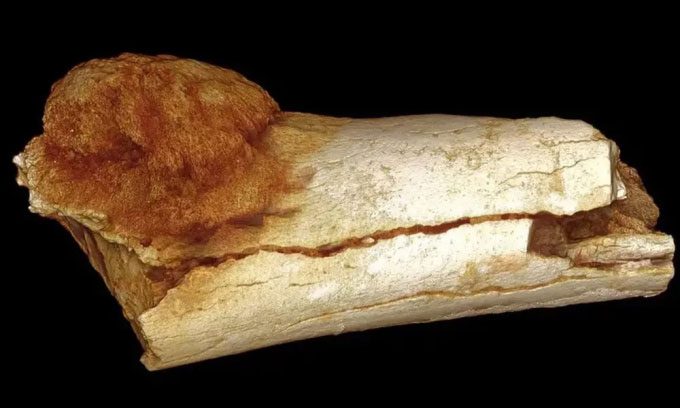The earliest evidence of cancer in humans belongs to an individual who lived approximately 1.7 million years ago, with a malignant tumor in their toe bone.
Cancer may seem like a modern disease, but it has actually affected humans for a very long time, as reported by Live Science on May 8. Scientists have discovered numerous prehistoric remains that indicate the presence of cancer. So, what is the oldest recorded case of cancer?

The oldest recorded case of cancer occurred 1.7 million years ago with a tumor in the toe bone of an individual related to modern humans. (Image: Patrick Randolph-Quinney/UCLAN)
The earliest evidence of cancer in humans belongs to a relative of modern humans who lived about 1.7 million years ago. This individual likely belonged to the Paranthropus robustus or Homo ergaster species and had to live with a malignant tumor in their left toe bone. Archaeologists discovered the skeleton in Swartkrans Cave, a limestone quarry in South Africa often referred to as the “Cradle of Humankind” due to its concentration of the largest number of modern human relatives’ remains in the world.
When comparing computed tomography (CT) scans of the toe bone fossil with modern images of osteosarcoma (a type of cancer that begins in the bone-forming cells), researchers immediately recognized the characteristic cauliflower-like shape of the malignant bone tumor, according to a study published in the South African Journal of Science in 2016.
Today, osteosarcoma is one of the most common types of bone cancer in humans and can occur at any age, although it is most frequently found in children, adolescents, and young adults, according to the American Cancer Society. The individual with cancer in Swartkrans Cave has not been aged, but appears to have been fully grown.
According to another study published in the South African Journal of Science in 2016, experts discovered an even older benign tumor in an individual of the species Australopithecus sediba, a human relative from 1.9 million years ago.
It is not surprising that the oldest recorded case of cancer is found in bone as organs, skin, and other soft tissues are more prone to decomposition than bone. “Bone is one of the few tissues that can survive in the fossil record,” said Bruce Rothschild, a vertebrate paleontologist at the Carnegie Museum of Natural History.
However, even when fossils have cancer, scientists often cannot see it with the naked eye and need further examination to confirm. The aforementioned case of toe bone cancer is no exception.
“About one-third of cancer cases will reveal themselves. But you need to conduct X-rays to determine if something is hidden inside the bone. When it comes to bones, most pathology researchers today look at X-ray images before making a diagnosis about the tumor,” Rothschild noted.
The earliest known case of cancer in the Hominin lineage occurred 1.7 million years ago, but the first recorded account of cancer appeared much later. In 3000 BC, Imhotep – an ancient Egyptian mathematician, physician, and architect – wrote the Edwin Smith Papyrus, a “textbook” on bodily injuries and surgical procedures.
In this document, he detailed 48 medical cases, including some studies on breast cancer. The Edwin Smith Papyrus not only provides insights into how ancient Egyptians performed surgeries thousands of years ago but also offers some of the earliest evidence of cancer.


















































